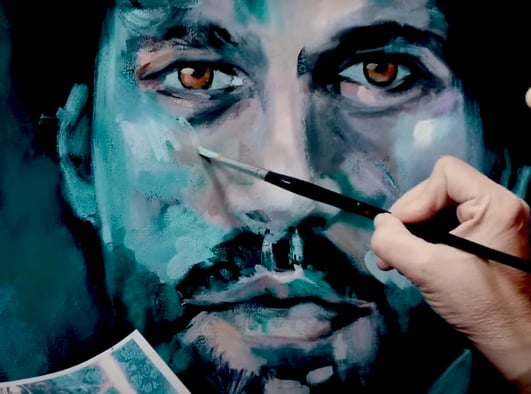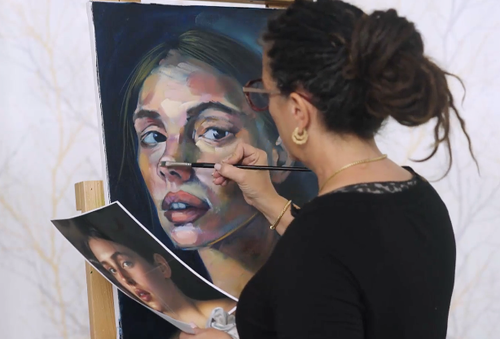Acrylic portrait painting offers a dynamic, fast-drying, and expressive medium for capturing the human form. At Milan Art Institute, the mission is to empower artists to master both the technical and emotional dimensions of their craft. This guide shares essential acrylic painting techniques, insights on creative discipline, and ethical practices that form the foundation of professional artistry.
1- Starting Strong: Drawing Foundations and Underpainting in Acrylic
Angular Line Drawing for Structure 
Acrylic portraits begin with a strong foundation. Using angular line drawing helps map out the proportions and structure of the face, enabling you to achieve accurate placement and dynamic composition before the painting process begins. Many people have been taught the grid method for drawing, we recommend using a proportional scale tool to properly sketch in and measure your source.
Acrylic Underpainting as a Base Layer
Use an acrylic wash (acrylic paint and water) to fill in all the white on your canvas. Block in saturated colors where darker tones are needed. Try using a pre-made photo source to guide your choices. The underpainting serves as a roadmap for the entire piece. With acrylics, this layer dries quickly and will allow you to establish key values and tonal contrasts early on. This foundational step sets the tone for realism and helps maintain clarity when adding subsequent layers.
2 - Developing Realism: Brushwork and Color Theory in Acrylics
Brushstroke Direction
In acrylic portrait painting, brushstroke direction should follow the planes of the face. Rather than overblending, use deliberate strokes to define structure and add volume. This approach enhances the dimensions of the portrait while preserving energy and character in your work.
Embracing Visible Brushwork
Acrylics naturally lend themselves to bold, visible strokes. Allowing these strokes to remain in the finished work can add movement, expression, and personality. This technique not only contributes to a painterly aesthetic but also connects the viewer to the artist’s process. Collectors love brushstrokes, making you painting more sellable.
Mixing Skin Tones with Warm and Cool Colors
Acrylic portrait artists must develop skill in mixing nuanced skin tones. This involves understanding the balance of warm and cool hues to create lifelike depth. Strategic use of temperature contrast brings vitality and realism to the skin, avoiding flat or unnatural results.
3 - Reference Images
Choosing Effective Source Material
Reference photos should be selected with intention. Look for images with strong lighting, clear facial features, and emotional resonance. These elements enhance the final portrait and support a more compelling interpretation.
Upholding Artistic Integrity
Always use reference photos ethically. Avoid copying copyrighted material or another artist’s work. Instead, use personal photography, royalty-free sources, or modify references substantially to create an original expression. *For more copyright information, check out Jake Dunn's breakdown of what you can and can’t do when it comes to using reference photos in your art, based on U.S. copyright law.
4 - Overcoming Resistance: The Inner Work of an Artist
Identifying Resistance
Artists often face resistance—whether in the form of self-doubt, procrastination, or fear. These mental roadblocks are natural and often signal the importance of the work being avoided.
Creating Through Challenge
Success in acrylic portrait painting isn’t just about technique—it’s also about persistence. By acknowledging resistance and continuing to create despite it, artists develop resilience and creative momentum that lead to breakthroughs in both skill and confidence. Challenge yourself to do something uncomfortable, like painting a self-portrait every six months to a year. It will feel vulnerable, but over time, you will see your progress and be more confident in creating portraits.
5 - Smart Studio Practices: Tools, Health, and Technique
Sustainable, Non-Toxic Materials
Acrylic painting is already a more eco-friendly option than some other mediums, but it's still important to use safe and sustainable materials. Choose non-toxic paint thinners and cleaners when needed, and maintain a well-ventilated space.
Proper Brush Care and Application
Brushes are essential tools in acrylic portrait painting. Clean them promptly and thoroughly to avoid damage from drying paint. Apply acrylics in controlled layers, using varied pressure and brush types to explore texture, edge control, and flow. Try using walnut oil for a safer, non-toxic cleaner.
6 - Grow Within a Creative Community
Connect with Fellow Artists
Artists thrive in community. Milan Art Institute offers an active network of creators who share feedback, offer support, and encourage one another. Participating in an online community can be a powerful source of accountability and inspiration.
Access Additional Learning Resources
Continued learning is key to artistic growth. Artists are encouraged to explore instructional video series, take advantage of discounts, and participate in giveaways to expand their skills and deepen their understanding of acrylic portrait techniques.
The Power of Acrylics in Portraiture
Acrylic portrait painting is a vibrant and versatile practice that combines precision with spontaneity. With the right guidance, tools, and mindset, you can develop a unique voice and produce work that is both technically strong and emotionally resonant. At Milan Art Institute, the goal is to cultivate artists who are confident, ethical, and expressive—ready to pursue their creative calling with passion and professionalism.
Start Your Art Career With Us
After successfully training thousands of students worldwide, the Milan Art Institute has perfected turning anyone into a professional artist in as little as one year. The program provides training and mentorship from professional artists. It allows students the flexibility to work at their own pace—a perfect opportunity for aspiring artists who work at a day job. Embark on your journey from art passion to art profession with The Mastery Program!


